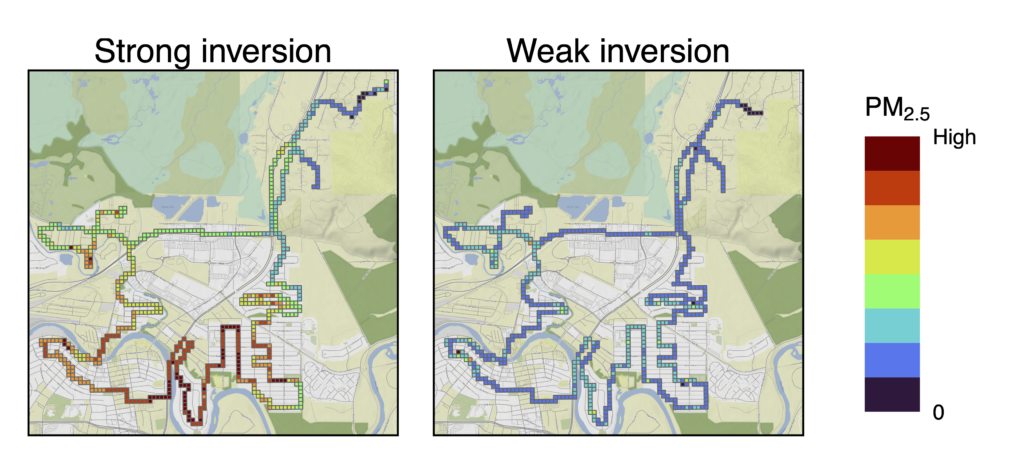By Ellis Robinson
Residents in Fairbanks, unlike in many other places, can experience air pollution through the senses in wintertime. Smell tells us that something about the air is very different in winter than in late spring. Sight lets us note the hazy air layers that can develop over town and even let us see plumes of wood-burning or vehicle exhaust that just seem to sit in place. In much of the Lower 48, air pollution is less viscerally real and becomes “an invisible problem.” In Fairbanks, air pollution can be sensed just by stepping outside.
Some aspects of Fairbanks’ wintertime air pollution are more hidden, however.
Did you know that levels of particulate matter just east of downtown are significantly higher than in the Shannon Park neighborhood? Or that the air is much cleaner even halfway up Birch Hill than at the base of the hill? These differences are what researchers refer to as “hyperlocal air pollution,” where levels of pollutants can vary significantly across a city, even over short distances. Quantifying these differences, which are important for understanding potential health impacts, can be a complicated challenge.
During the winter of 2022, using a vehicle outfitted with air pollution sampling equipment (a “mobile lab”), a small research team visited different neighborhoods in Fairbanks to assess the levels of three air pollutants: particulate matter, black carbon and fine particles, each of which affect health.
Typically, air pollution is measured continuously at a monitoring site in a single location, which gives detailed information but only for that location. By moving monitors around with a mobile lab, it’s possible to see how air pollution differs among many places — neighborhood to neighborhood and even block to block.
Using mobile monitoring required numerous visits to different parts of Fairbanks, eventually allowing underlying patterns to emerge. Visiting two neighborhoods once or twice does not provide enough data to discern differences.

Map of pollutant concentrations during strong and weak inversions across Fairbanks neighborhoods and different elevations. Graphic by Ellis Robinson
The biggest finding from this effort is that Fairbanks experiences large neighborhood-to-neighborhood differences for each of the three pollutants.
There is a major caveat, though: The strong differences among neighborhoods during temperature inversions go away almost completely without an inversion.
For example, particulate matter in the Bentley Island area is typically much higher than in Shannon Park but only under the right meteorological conditions. Researchers call this a “horizontal difference.”
For particulate matter, the horizontal difference between Bentley Island and Shannon Park is almost double under inverted conditions but equal without an inversion. This particular result makes sense when considering emissions sources: Shannon Park shares a border with a lot of open area where woodstoves and vehicles — major sources of these pollutants — are absent. Bentley Island, which borders downtown and Hamilton Acres, contains its own neighborhood sources while also being surrounded by many others.
Because inversions trap pollution, it spreads out only very slowly, magnifying differences in the density and distribution of emissions sources between different places.
The mobile lab also measured strong “vertical” differences in pollutant levels when it drove up Birch Hill from town.
Pollution levels at low altitudes compared with higher altitudes could be stark: pollution could be very bad in town while being almost nonexistent even just 165 feet higher in elevation.
The research team used a few steep roads on the side of Birch Hill near town to look at how these pollutants changed with elevation. Lower pollution at higher altitude is good news for those exerting themselves (and breathing lots of air) on Nordic skis, though that difference exposes major inequality: Sometimes not all of us breathe the same air, even when we live fairly close together.
The full results from this study titled “Wintertime spatial patterns of particulate matter in Fairbanks, AK during ALPACA 2022” were recently published and is a first step toward better understanding differences in pollutant exposure between neighborhoods of Fairbanks. It highlights the major role that meteorological conditions play in creating these differences.
This Community Perspective is a part of a series of articles on air quality research performed as a part of the UAF-led Fairbanks Winter Air Study (https://fairair.community.uaf.edu). Ellis Robinson is a research engineer at Johns Hopkins University.


